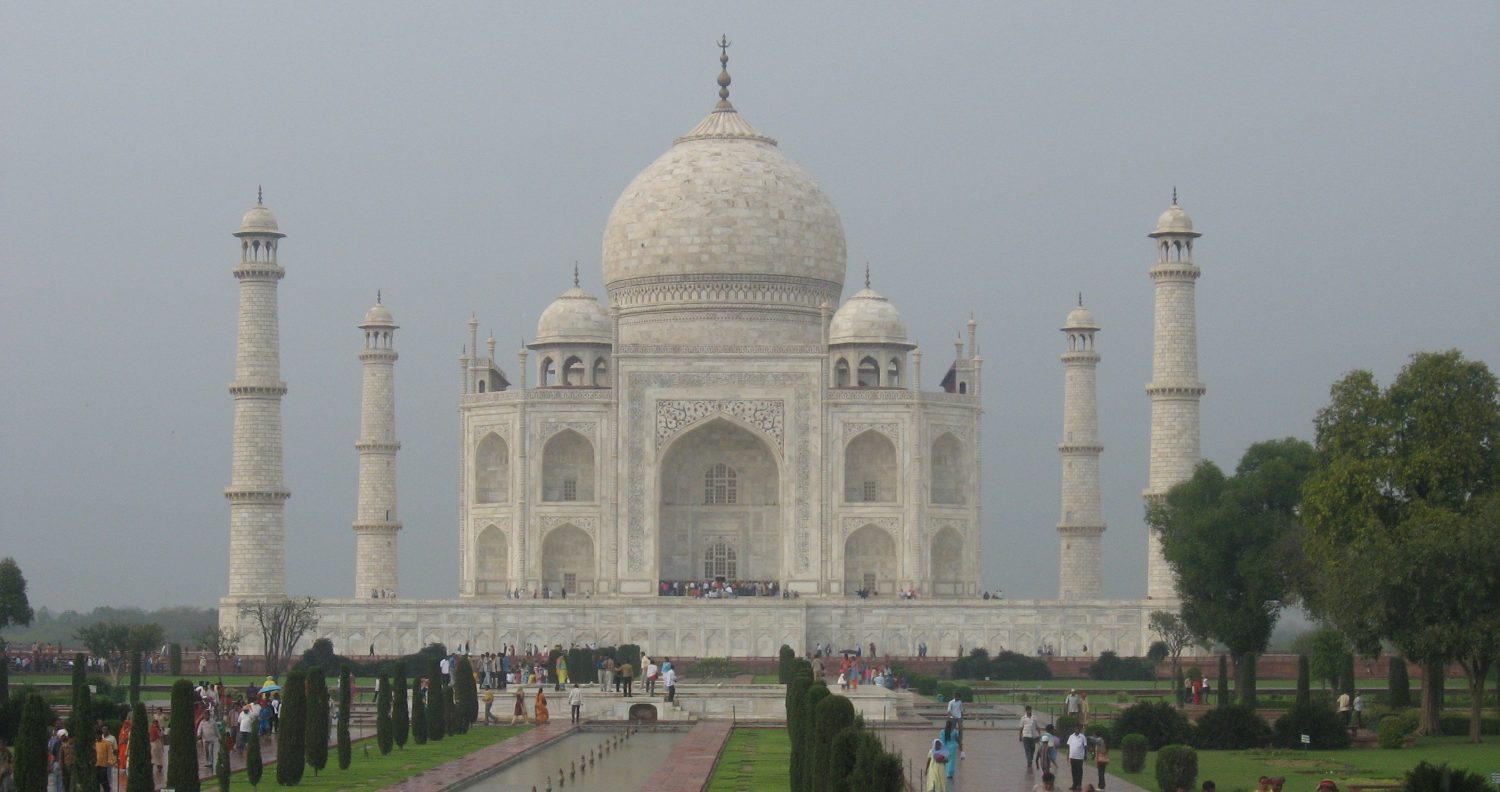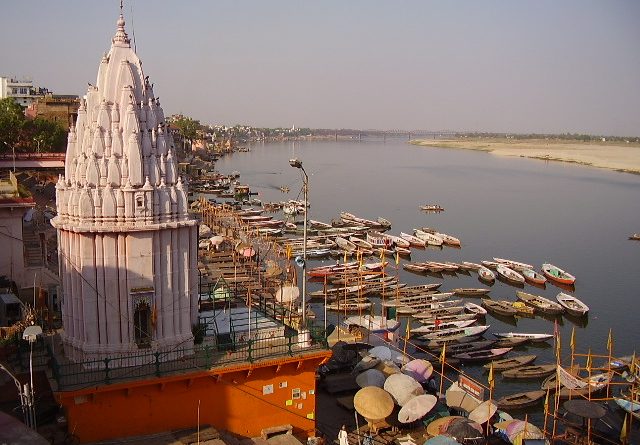Along the holy Ghat in Varanasi
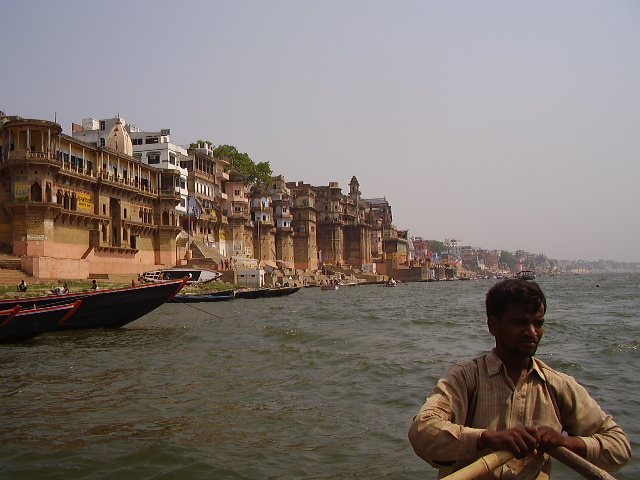
Awaking on the Varanasi Ghat
I wake up at 4.00 in the morning: the monks’ chants from the tiny adjacent temple reach me as a profound call from the Universe; “Ohm nama Shiva” slowly they repeat in chorus without stopping. As if I got caught by an electric shiver, I get up and as soon as the first lights enlight the sky I go out. It’s about 5.00 in the morning; I quickly reach the Ghats, hoping to attend the morning prayer which is not actually celebrated here.
I admire for the first time the whole shore that runs alongside the Ganges: a transparent impalpable light delineates, as if by magic, rows of gray terraced platforms that loom on the horizon at whose beginning rise mighty walls of ancient sand-colored buildings. In front flows Mother Ganga: extended, silty, slow and dark. The bank beyond is unlikely to be bare.
In India, where even in the desert appear people who offer you something to buy, where wherever you go you never have the possibility of being alone; that emptiness that appears in front of me dismays me, as if the earth ends up right on the shoreline of the river.
In the clear and fresh air of early morning, I sit and watch the city wakes up. Fishermen offortune repair or prepare their nets as soon as they return from their hunting trips. Other men sleep in their small wooden boats, they are the Charont of the sacred river.
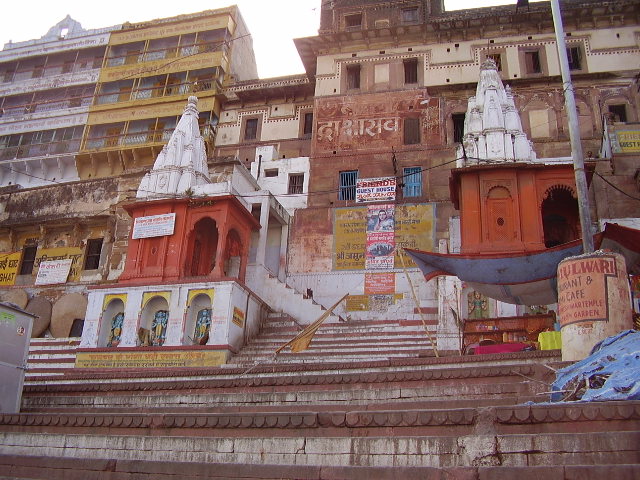
From Asi Ghat to Dandi Ghat

My journey starts from Asi Ghat, so called for the dirty little river that ends its course here. A few dozen meters ahead, appears Tulsi Ghat, dedicated to the 17th century poet Gosain Tulsi Das who translated Ramayana from Sanskrit to Hindu and died here. I climb the staircase to get a close-up view of the open three-porticoed gallery of the two-storey building built on it. The interiors are full of rubble, so I decide to continue further.
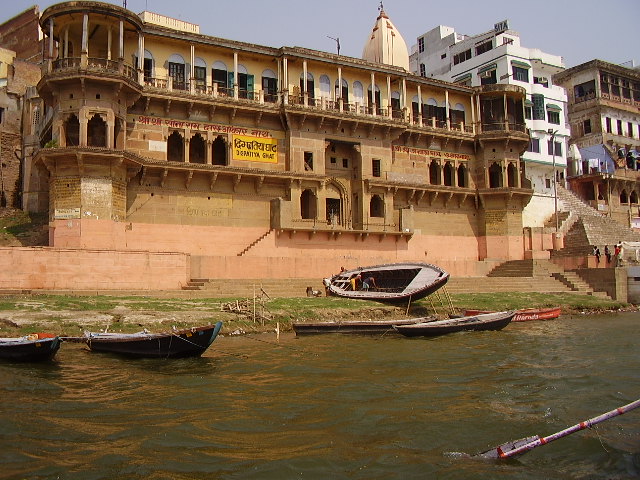
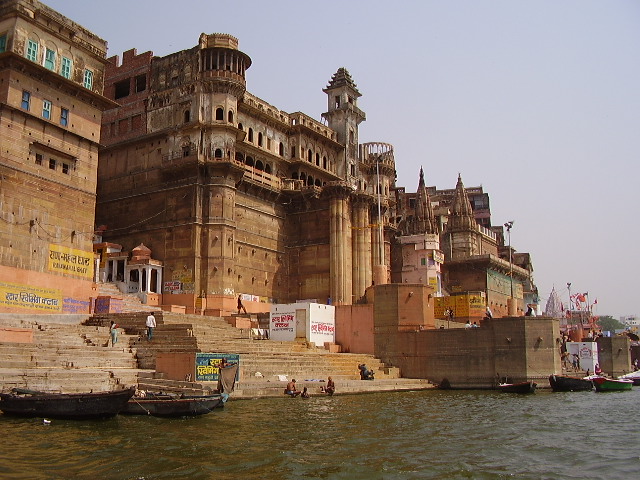
At Jain Ghat an austere facade is dominated by a small golden spire, the central body of the temple dedicated to the seventh Tirthankara Suparshvanatha, born near this neighborhood. Further on at Brabhu Ghat the walls rise as if to repair three temples dedicated to Shiva. Here the Budhwa Mangal Festival is celebrated for seven days.
Continuing on, I admire an ancient castle whose mighty gray walls are embossed by angular towers of the same height. Above, three floors dominates the Ghat with rows of arched windows, from which I would like to admire the panorama. The place is Darbhanga Ghat, while the fortress, once the palace of marajhà, is now used as a luxury hotel.
Few monks start to enter into waters half naked for their morning bath; one of them unties the long rastas to wash them thoroughly; no one swims, only ritual ablutions. Other monks dressed in orange are in deep meditation in a lotus pose on the highest steps. I see a young monk so into deep trance that his eyelids open to reveal the white back of the eyeball. I find myself at Dandi Ghat, where Dandi ascetics gather, often dressed only with ashes. A small red spire stands beside a tiny temple half hidden by the steps.
Impressed by the young monk, I keep walking along the ghats; so I am not disturbed in the morning except by a small herd of goats descending towards the river. One of them seems interested to my bag where I keep my precious notebooks; amused I take my few belongings and I go away, afraid to annoy some Hindus for my western ways, not appropriated for the place where I am.
From Harishchandra Ghat to Raja Ghat
I arrive at the first cremation Ghat, Harishchandra Ghat, where worn pyres smoke lined up. The activity still seems to be suspended given the morning hour. Ready-to-use stacks of wood lie in a row next to the walls. I am not ready to find out what is happening here, I prefer not to dwell further.
The steps descend towards the river steep, chipped and whitish. They suddenly become red stripes alternating with white, I look towards the city and find myself spied on by numerous grotesque statues of brumelic gaudy deities ready to come alive in one of the passersby. The Ghat is called Kedar, but the temple that houses this spooky theater is closed.
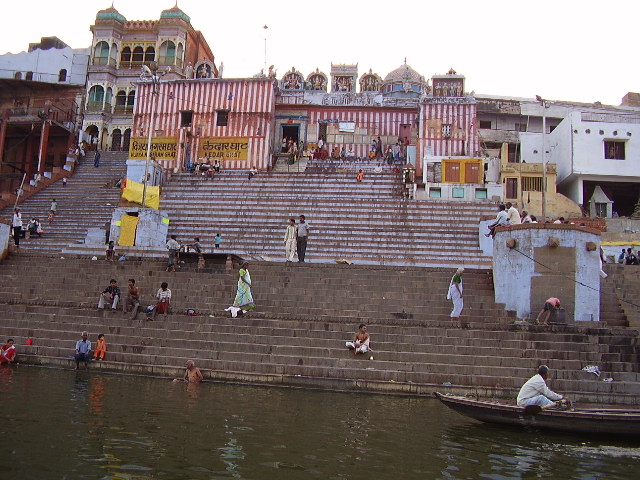
My journey continues and I find myself in the Dhobi Ghat, where at 6:00 in the morning already the washerwomen and laundromats are busy washing in the Ganges pieces of cloth several meters long. With the clothes gathered on the pelvis, the women cheerfully spread bright saris and voluptuous patches full of light on the wide steps so that the rays of the morning sun quickly dry the precious artifacts without discoloring them. Next to it are T-shirts with Leonardo di Caprio’s face printed, a contrast that makes me smile.
The gray of the angular stairways contrasts with the soft and warm lines of the buildings that parade along the shore, some are decadent and residential, others are small ocher-colored temples with sikhara-style domes or mighty walls of ancient palaces, with domes and arches in Mughal style, whose pastel colors seem to vary with the mood of light, as in Raja Ghat.
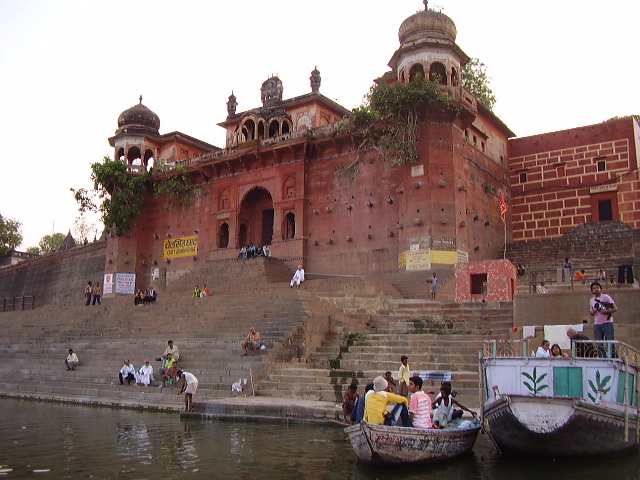
Dashashwameddha Ghat and Lalita Ghat
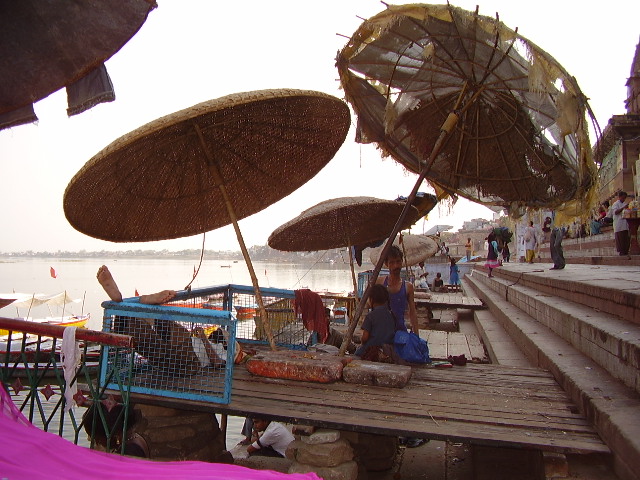
The sun begins to burn, even for men intented on repairing boats with hammers, drills and pitch, whose nauseating acrid smell joins the cow’s piss colliding with Ganges’ scent which for a strange reason reminds me the saline of the sea. Pitch has the upper hand and the heat begins to make me feel fragile and defenseless.
I seek shelter in the streets, which are open-air stables. I take refuge in a three-star hotel, where I spend the hottest hours having a warm breakfast under the breath of fans. I can’t stay in the same place for long. Despite the imperious heat, I go out and continue my journey on the Ghats, surrounded by the locals now. Some stop me for proposing guides, I want to be alone and I deny everyone.
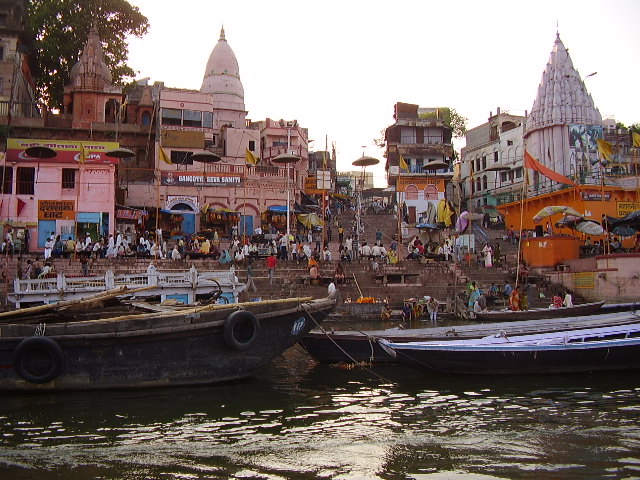
A flood of screaming children dressed in rags leaps from the bases of some bare and low bastions directly into the Ganges; their joy fills me with peace. Some black bulls go down the steps to drink. Numerous women wash their long soapy braids, rigorously dressed in their gaudy saris. A holy man soapes and washes his black dog. Monkeys climb the windows, between the bars of civilian houses they try to grab food. An amused girl hands them pieces of fruit from the third floor.
Frantic I arrive at Dashashwameddha Ghat, from which starts the main road that crosses the center of Varanasi where the market is located. A large square gives space to small wooden boxes topped by round crumpled umbrellas full of holes, under which the merchants are engaged in their activities. It will be the suffocating heat of midday, but what should be the beating heart of the center is now deserted: only a barber soapes a customer who admires the shore, the others carelessly take a nap under the beloved shadow of their old umbrella.
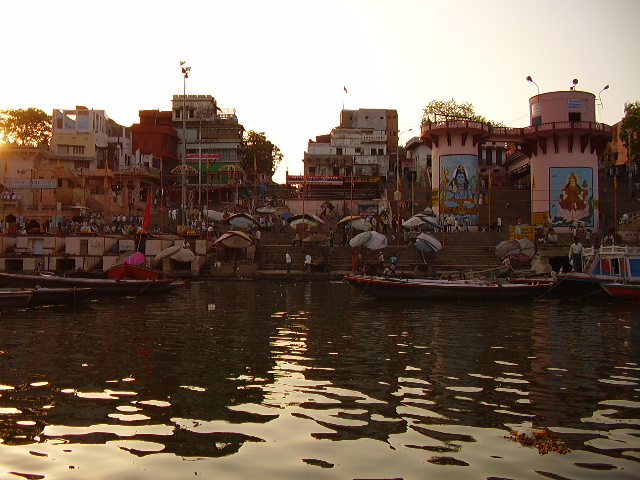
Walking on I discover Lalita Ghat, built by the king of Nepal at the beginning of the last century, where the splendid Nepalese-style Keshava wooden temple stands inside, reproducing the Pashupatinath of Kathmandu. Square in shape, the open space portico hostes intricate high reliefs of divinities that mingle with erotic scenes, similar to those of Kajuraho, but not so elegant. Two overhanging upper orders full of loggias culminate with a sikhara.
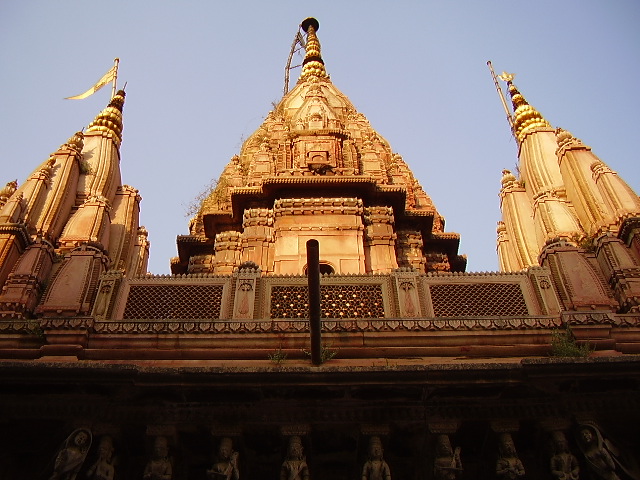

I rest from the strong sun rays that make the place, fortunately for me, desert; if not for some young monks dressed in orange tunics who observe me curiously. As if moved by a magnetism, I dragged myself stunned to Ghat Jalasai, finally, full of spirituality, as if all the while I had done nothing but climbing steps towards the ancestral: I am ready to see the destruction take shape.
The Burning Ghat, Manikarnika or Jalasai Ghat
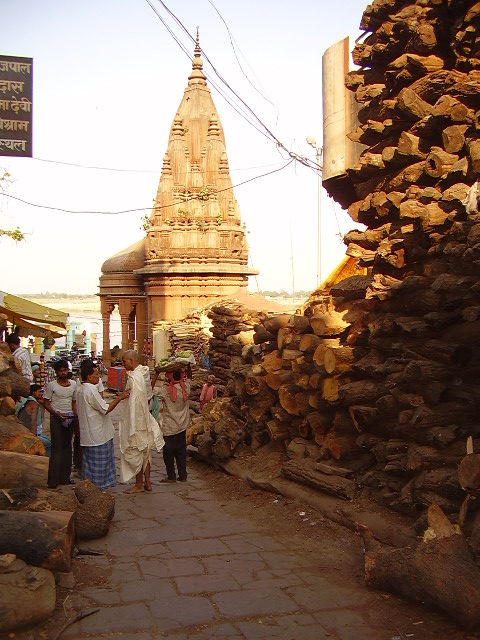
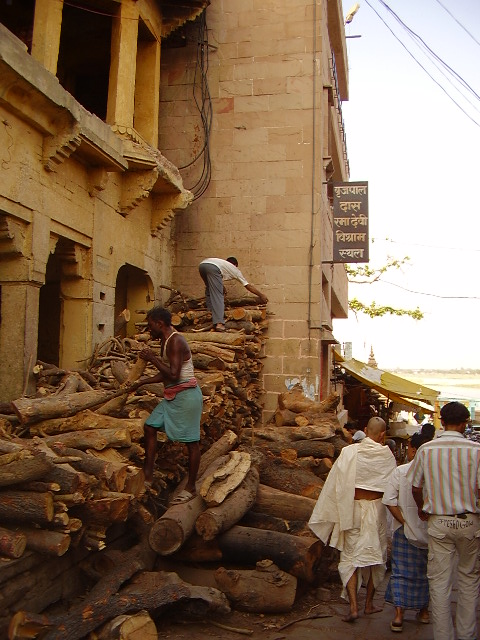
I cannot continue my journey, I am forced to go up as a woman, to whom direct access to the front is prohibited. A guy approaches me and forcefully pushes me into the interior of the city. I quietly obey his not really polite words. Slowly I go up and look at the stacks of wood arranged along the walls of an ancient stone house. A mongoose escapes and hides between the timber and the memory of the Jungle Book resurfaces, that book that so much conditioned me in coming to this place.
I watch busy men weighing pieces of wood contracted as precious goods on rusty blue iron balances. I do not know by what force I am dragged into the cottage, which I find to be the place where foreigners can watch the burning ghat. The cottage is a bare temple, from whose openings one can observe what certain eyes want to look at.
With a bit of anxiety I approach and see the Burning Ghat in all its destructive greatness. Different pyres are placed in descending linear order; some are ready, others are burnt or about to burn. A corpse is placed on one of them. The body is covered only by a golden mantle, which is scattered with some ointments.
Next to it there are three sons with shaved head, dressed only in a white tunic. A caste-free, here considered to be Shiva’s direct aides, hands to a son, I suppose the major one , newly lit torch. The son pulls the cloak aside and he kisses the father’s forehead. He makes three turns around the pyre and then sets it on fire. Everything happens in utmost silence.
Fire immediately devours the golden cloth to reveal scorched feet and it begins to burn the stiffened skin that turns black instantly. An acrid smell of flesh also reaches my height. The deceased’s family decides to leave the scene. I remain.
The casteless man has with him a long green rush, with which he arranges the wood that slowly falters. Not only. As soon as he considers the body burned sufficiently, with his stick he breaks the lower limbs at the height of the knees with a sharp gesture, turning over what remains on fire. The cracking of the bones makes me shiver.
When remains only a shape of the body, the guardian of the pyre stabs the deceased’s chest to turn it over. Now the fire subsides, the cremation proceeds slowly, until the whole body disappears joining the flames, gradually losing shape, except for the skull. Not everyone can afford wood, if there is not enough, cremation does not take place so quickly: the body takes much longer to become ash, revealing all its parts.
Goats and dogs have free access between the pyres; strays sniff bones remained intact at cremation; while Shiva’s aides continue to turn the bodies over like a macabre concert. The ash that eventually remains is swept by other workers to the river that swallows everything.
I watch the ignition and ascension of three other pyres hidden in my little hole where nobody disturbs me. It seems strange, but in these three long hours spent above the Burning Ghat a deep peace descends in my heart, as if every fiber of my being was in harmony with everything around me.
From Shiva’s places to the trip by boat with Charon
An old woman appears at the door accompanied by a young man who asks me: “Sorry, this woman has no money and she needs it to buy wood for her cremation.” Her face is furrwed with a cobweb of wrinkles, but her deep brown eyes stand out conspicuously. I offer her some coins and the young man, annoyed by the fact that I have not given him the money, first he takes me back for the ridiculous sum offered, then argues with the old woman for his part.
The quiet I was feeling is now broken, I go in Northern direction to find the most sacred place of all on Manikarnika Ghat: under a simple loggia I see a high relief on the floor with what should be the footsteps of the god Visnhu when he came to earth. Next to it I see a fenced swimming pool that descends in steps: according to legend, Shiva’s wife, Parvati, would have thrown her earring here and then she asked Shiva to look for it on the banks of the Ganges. The idea was not to let him find it the way Shiva would be always around.
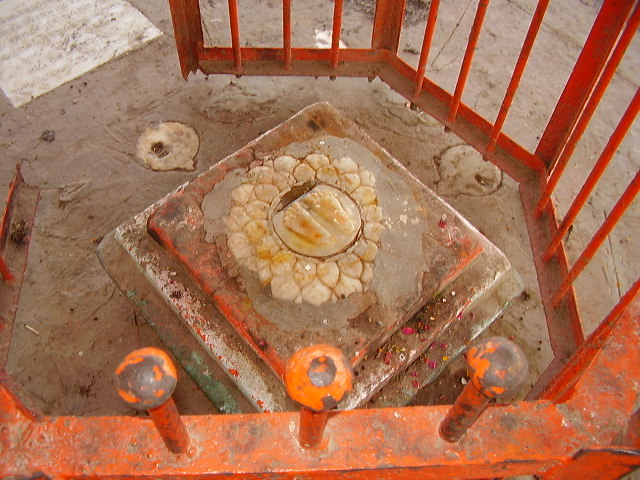
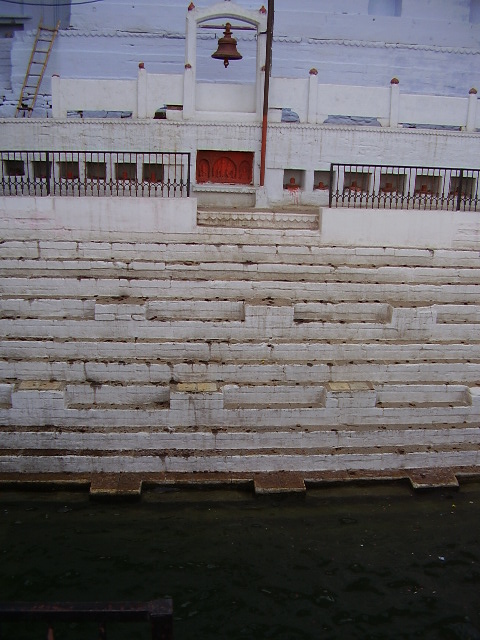
Going down to the shore, on Scindia Ghat, I meet an old man, who appears in front of me with a huge toothless smile under a thick gray mustache. He offers me a ride in his boat. I am still in a trance and staring at him in his magnetic brown eyes I can not help but accept. His old wooden boat is docked right next to the decadent Shiva temple, slanting in the water due to its excess weight and bad engeneering calculations.
I don’t even ask how much he wants, but my Charon Shiva does everything to make me feel at ease while he is lightly rowing on the dark waters of the Ganges. “Mam are you okay? Are you comfortable? ” I nod thoughtfully and it will be the melancholy that takes hold of me that worries him. With the palms of his hand he collects the water from the river to quench his thirst. “But doesn’t it make you sick?” “No, I’ve had antibodies since I was a kid.”
It all makes sense given the children who throw themselves hilariously into the waters right next to the burning ghat, while the women continue to wash their clothes. He takes me with broad strokes of oars to the forbidden shore, where he offers me smoke. He pulls out a small terracotta cilum and pacific he begins to pull. Tiny gray frogs jump into the boat.
By now the sunset is falling, the red sun gradually disappears, launching oblique rays that illuminate the even more mystical temples with orange beams. We remain silent to admire the decline of light. Now the silhouettes of the temples darken, the great Agni Puja begins and shamanic music spreads on the surface of the water.
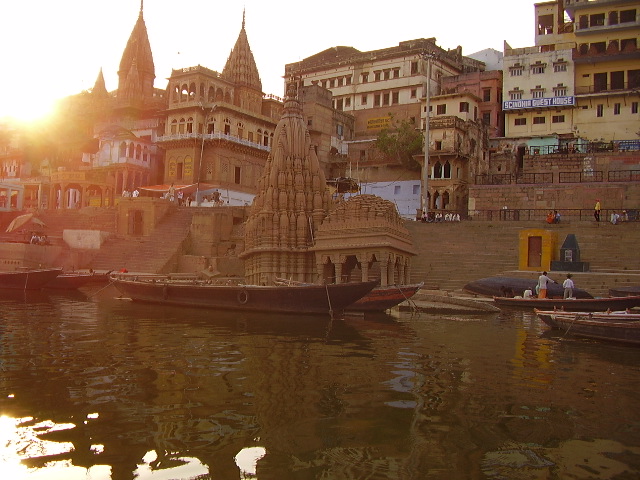
Above the oblique temple of Shiva a waning moon rises, with its belly facing the earth, as only at this latitude can it be admired. The Ganges takes up space, slow and immense, enigmatic belly. The lights of the Agni Puja are now reflected on the waters, mysterious monks celebrate it with rituals made of fire, incense, bells, drums and songs seen from the ruins of a temple and the devouring fires at a distance.
Suddenly I seem to be witnessing a miracle: in this temporal suspension the veil of Maia is torn and it reveals the border with a ravenous afterlife dimension in the most scratching darkness.
Charon Shiva leaves me in Dashashwameddha Ghat, where the puja is now over. “Namaste Erica, it was a pleasure to meet you” greets me by offering me his cilum which I still keep in his memory.
